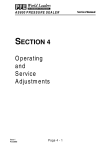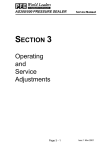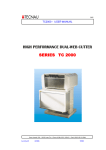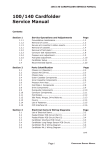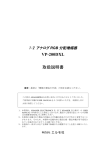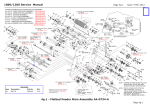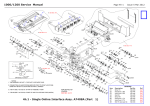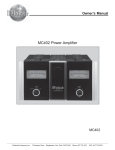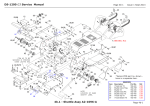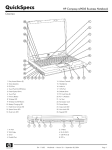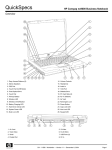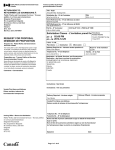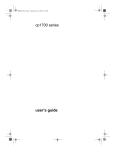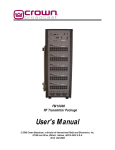Download SECTION 3 - SERVICE OPERATIONS
Transcript
DS-1200 G3 Service Manual Page 3-1 Issue 1 Sep 2013 SECTION 3 - SERVICE OPERATIONS Page Safety Notes, Power Source & Labels 3.2 Page 3.17 3.3.5 Shuttle & Kicker Belt Replacement 3.1 Preventative Maintenance Checklist 3.5 3.3.6 Turnover Belt Replacement 3.18 Maintenance General 3.5 3.3.7 Envelope Conveyor Belt Replacement 3.19 Service 6 Months / 1 million Inserts 3.5 3.3.8 Handover Belt Replacement 3.20 Reliabilty Information 3.7 3.3.9 Wetter/Closer Belt Replacement 3.21 3.2 Module Identification 3.9 3.4 Folder Maintenance 3.22 Feeder Interface 3.9 3.5 Envelope Opener Beam 3.23 Shuttle/Shuttle Bed 3.9 3.6 Remote Control Unit Setup 3.24 Track Cassette 3.9 3.7 Engineering Screen 3.26 Kicker/Handover 3.10 Hardware Setup 3.26 Turnover 3.10 Firmware Download 3.28 Envelope Opener Conveyor 3.11 Engineering Diagnostics 3.29 Feeder/Folder 3.11 OMR/Barcode Reader Setup 3.31 Wetter Closer 3.12 3.8 QX Hawk Reader 3.33 3.3 Drive/Conveyor Belt Replacement 3.13 3.9 Recommended Spares 3.38 3.3.1 Track Cassette Belt Replacement 3.13 3.3.2 Folder Drive Belt Replacement 3.13 3.3.3 Feeder Interface Belt Replacement 3.14 3.3.4 Feeder Conveyor Belt Replacement 3.16 Page 3-1 DS-1200 G3 Service Manual CAUTION! Prior to carrying out any maintenance procedures on the machine, the following safety precautions must be observed: • Switch the machine OFF by turning the isolator switch on the rear of the insert head cover to the ‘off’ position. Turning the switch does not isolate the PC from mains supply, which is left on for access to technical documentation. To switch this off also, the power cable must be isolated from the incoming supply by switching off at supply source. • If it is intended to access the mains distribution DIN rail behind the insert head, the machine must be isolated from the mains supply. Failure to isolate the mains could result in death or injury! The DIN rail is protected by an inner safety panel, retained along its top edge by 2 screws. The panel must always be replaced when maintenance work is completed. • Before switching the machine back on after completion of maintenance work, ensure all external covers are in place and undamaged. Replace any covers that are damaged. PUT SAFETY FIRST! The following electrical information for the incoming mains supply on the 1000/1200 must be noted. Mains wiring should not normally need attention and unless there is a specific reason, it should not be changed. Input Voltage 230v @ 50/60Hz (± 10% maximum) Power Connector Machine fitted with BS4343 32A IP44 industrial free plug connector, conforming to EN60309 1 & 2 and CEE17. Mating socket required at supply source. Notes: Page 3-2 Issue 1 Sep 2013 2. Changing the supplied plug negates any responsibility of the Company for the safety integrity of the machine. 3. Changing the supplied plug must be carried out by a qualified electrician. 4. If 2 x Hi-Cap Folders, a Hi-Cap and a Lo-Cap Folder or an OMR/Barcode Folder with any other unit are located next to each other on the same track pair, it is necessary to order and fit an additional power supply kit 184-156 to ensure correct operation. Incoming Mains Connections The mains is connected to the isolator switch located at the rear of the insert head, above the wetter fluid bottle. To gain access, remove the outer cover, then the plate holding the switch. Observe the polarity of the incoming mains cables - the brown cable (line) connects to L1, the blue cable (neutral) connects to N (note that colours may vary depending on locality). The cables exiting at the bottom of the switch are connected to the DIN rail fuses, as described below. DIN rail fuses The mains supply from the mains switch (see above) is connected to the main 30A fuses, located on a DIN rail with all other fuses at the rear of the insert head, below the envelope feeder. To gain access, remove the outer cover below the envelope feeder, then the cover panel inside. The main fuses are protected by a further cover, as shown below. Protective cover over fuses and mains cables. Warning: High voltage PC always live unless isolated at wall. 1. If for any reason it is required to change away from the supplied plug please note that the replacement device used must have a rated current carrying capability greater than 30A and meet all safety requirements for that country. Page 3-2 DS-1200 G3 Service Manual Page 3-3 Issue 1 Sep 2013 Earth Connections Warning and Safety Labels The earth wires from incoming mains, outgoing mains and the connection to all other fuses terminate at the main earth post. This is located at the rear of the insert head and is visible after removing the panel for the mains switch, as described on the previous page. The 1000/1200 is fitted with a number of warning and safety labels which must be in place and undamaged. If any are found not to be, they must be replaced. Labels are identified below. Rating and Compliance Plates Model No. Earth connection E1532BA OAQ 59 61 Located on inside of hinging top cover of envelope feeder Serial No. 115-230 V~ 50/60 Hz NEOPOST TECHNOLOGIES LTD NEOPOST TECHNOLOGIES LTD Loughton, Essex IG10 3TZ, UK Loughton, Essex IG10 3TZ, UK Model No. E1532BA Serial No. OAQ 59 61 Fuse caution label 2A G3297A Fitted to the electrical panel behind the PC, next to the socket connecting the PC High Leakage Current Label G3357A Fitted to the outer cover behind the insert head, below the envelope feeder Page 3-3 DS-1200 G3 Service Manual Page 3-4 Issue 1 Sep 2013 Warning and Safety Labels (cont.) Laser warning label G3363A Fitted on the horizontal surface close to the OMR/Barcode read head on all OMR/ Barcode units. Warning plate G3068A conveyor, and to diverter below top tray. Fitted to the top of opening covers on: collator; flatbed feeder, single O/L; vertical stacker (one of each of two covers); hi/lo-cap, feeder Page 3-4 DS-1200 G3 Service Manual Page 3-5 Issue 1 Sep 2013 CAUTION! 4. Observe the safety notes on the previous pages before carrying out any maintenance procedures. Lethal votages are present when the mchine is still connected to the mains. Print and check sensor calibration (see Engineering Diagnostics under section 3.5), then clean all sensors and re-check calibration. 5. Ensure the mains supply is completely isolated before removing any machine covers, or carrying out any other maintenance operations. Check envelope and insert side guides for movement, stop position and parallelism to chassis. 6. Check that steel overguide tapes on shuttles, insert track and kicker are not bent, twisted or damaged. Replace any that are. 7. Check that gas struts properly support all opening covers, envelope opener clamshell and collate unit conveyors (where fitted). Replace if any are defective or sinking. 8. If gears on insert feeder run noisily, lubricate sparingly with Molyslip MBG moly bentone grease. Raise cover at front end of feeder to access. 3.1 PREVENTATIVE MAINTENANCE CHECK-LIST (When all items have been carried out, worksheet must be signed to confirm). 3.1.1 GENERAL 1. Ask how the machine has been working lately and use this information as a guide for checking the machine. 2. Ask if there has been a change of use e.g. high production runs or a change of material. 3. Check the operator adjustments of the machine and the material being processed. 4. In addition to the above, carry out the following in individual modules. Note: rubber feed wheels/rollers must be cleaned using a clean, lint-free cloth dampened with water. Do not use any other cleaning agents. Feeders (insert and envelope) 1. Switch on machine and confirm that no errors appear on the display screen. Clean conveyor belts and inspect for damage. Replace if necessary. 2. Clean feed wheels and inspect for wear. Replace tyres if necessary. 5. If necessary, generally instruct the operators again with regard to their specific problem area. Folders 6. Enter the total forms count on the service sheet. 1. Clean fold rollers and inspect for wear. Replace if necessary. 7. When all service or repair operations have been carried out, the machine must be left with all parts reassembled, leaving no risk of injury. 2. Clean output wheels and inspect for wear. Replace tyres if necessary. 3.1.2 SERVICE AT 6 MONTHS OR 1 MILLION INSERTS (1000) or 1.5 MILLION (1200) 1. Implement the actions in section 3.1.1 ‘General’. 2. Remove all machine covers. 3. Vacuum clean all modules to remove internal dust. Clean all covers. Hi/Lo capacity feeders 1. Clean feed wheels and inspect for wear. Replace if necessary. Page 3-5 DS-1200 G3 Service Manual Track Page 3-6 1. Check pawled belts for tension and wear. Replace if necessary. 2. Check pawled belt pulleys for wear. Replace if necessary. 3. 3. Issue 1 Sep 2013 Clean wetter reservoir. Replace tank if necessary. Collator 1. Clean conveyor belts and inspect for damage. Replace if necessary. Check stepper motor belts for tension and wear. Replace if necessary. 2. Clean feed wheels and inspect for wear. Replace tyres if necessary. 4. Check all paper control springs for damage. 3. Check that gas struts support covers and conveyors. 5. Clean track cassette solenoids. 4. Check, and if necessary replace the collate pocket backstop springs. Envelope opener 1. Check opener plate for wear. Replace if necessary. 2. Clean conveyor belts and inspect for damage. Replace if necessary. 3. (1200 only) Using ‘DC Motors’ in the engineering screens, run the envelope side guides, at HP1 & HP2 in and out to check operation and free movement. If operation is sluggish then remove the overguide assembly to gain access to and service the side guide assembly. Kicker 1. Check pawled belts for wear. Replace if necessary. 2. Check pawled belt pulleys for wear. Replace if necessary. 3. Check stepper motor belts for wear. Replace if necessary. 4. Check tips of insert fingers for wear. Replace if necessary. Note that for the 1200, the finger tips are independently replaceable. Handover 1. Clean pawled belts and check for wear. Replace if necessary. Wetter closer 1. Clean conveyor belts and rollers. 2. Check wetter sponge and roller. Replace if necessary. Page 3-6 DS-1200 G3 Service Manual 3.1.3 RELIABILITY INFORMATION (1000 series) The following reliability information applies to 1000 series. See following page for 1200 series figures. 1. (MCBE) Mean Cycles Between Error This is the mailing reliability of the machine and is based on a job, which has been fully set up to run at its best performance for documents, speed, etc. Achievable MCBE better than 1/1000. 2. (MTBF) Mean Time Between Failure (Service Call) This is the mechanical reliability of the machine between Service Calls and assumes the machine has been properly maintained. ‘Failure’ does not necessarily mean the machine has broken down but that the customer has requested a service call that cannot be overcome by phone support. The MTBF is based on a 4 station machine with an IS collate unit and 3 feeders. We also assume that the collate unit is processing an average of 2 sheets per document. Page 3-7 Issue 1 Sep 2013 from the machine. In this case the MTTR would be 4 hours. It should also be noted that a technician would normally expect to remain on site, after a repair has been made, to ensure that normal running has resumed. It is estimated that this is a minimum of 1 hour. 4. Machine (Service) Life The machine is designed to have a service life of:Machine Life 30M cycles. The life of the machine does not mean that it cannot be used beyond this number of cycles. The life of the machine is based on the fact that many of the functional mechanical components are designed to last 30 million cycles. Subsequently, after 30 million cycles the machine must be inspected to determine what components/modules need to be replaced to allow the machine to be returned to a serviceable unit. Service contracts will not be offered on machines that have not been inspected and refurbished after 30 million cycles. Estimated MTBF 300,000. 3. (MTTR) Mean Time To Repair Repair times for the 1000 need to be broken into 2 categories: a) Time to get machine back up and running. MTTR 2 hours. b) Time to repair a module fault away from the machine (machine already repaired and running). This is usually possible due to the modular nature of the machine. MTTR 2 hours The worst case here would be for a module to take the maximum time to diagnose and replace followed by the maximum time to repair away Page 3-7 DS-1200 G3 Service Manual 3.1.4 RELIABILITY INFORMATION (1200 series) The following reliability information applies to 1200 series. See previous page for 1000 series figures. 1. (MCBE) Mean Cycles Between Error This is the mailing reliability of the machine and is based on a job, which has been fully set up to run at its best performance for documents, speed, etc. Achievable MCBE better than 1/1500. 2. (MTBF) Mean Time Between Failure (Service Call) This is the mechanical reliability of the machine between Service Calls and assumes the machine has been properly maintained. ‘Failure’ does not necessarily mean the machine has broken down but that the customer has requested a service call that cannot be overcome by phone support. The MTBF is based on a 4 station machine with an IS collate unit and 3 feeders. We also assume that the collate unit is processing an average of 2 sheets per document. Page 3-8 Issue 1 Sep 2013 from the machine. In this case the MTTR would be 4 hours. It should also be noted that a technician would normally expect to remain on site, after a repair has been made, to ensure that normal running has resumed. It is estimated that this is a minimum of 1 hour. 4. Machine (Service) Life The machine is designed to have a service life of:Machine Life 40M cycles. The life of the machine does not mean that it cannot be used beyond this number of cycles. The life of the machine is based on the fact that many of the functional mechanical components are designed to last 40 million cycles. Subsequently, after 40 million cycles the machine mustbe inspected to determine what components/modules need to be replaced to allow the machine to be returned to a serviceable unit. Service contracts will not be offered on machines that have not been inspected and refurbished after 40 million cycles. Estimated MTBF 400,000. 3. (MTTR) Mean Time To Repair Repair times for the 1200 need to be broken into 2 categories: a) Time to get machine back up and running. MTTR 2 hours. b) Time to repair a module fault away from the machine (machine already repaired and running). This is usually possible due to the modular nature of the machine. MTTR 2 hours The worst case here would be for a module to take the maximum time to diagnose and replace followed by the maximum time to repair away Page 3-8 DS-1200 G3 Service Manual Page 3-9 Issue 1 Sep 2013 3.2 MODULE IDENTIFICATION The machine is constructed of a number of modules, each one being removable and serviceable as a separate unit. Each module has a unique name, and these names are used uniformly throughout all documentation and software, and must also be used if referring to Technical Support Department. Feeder Interface All modules are listed below: Fig. 1. Feeder Interface Fig. 1. Shuttle Fig. 2. Shuttle Bed Fig. 2. Track Cassette Fig. 3. Kicker Fig. 3 & 4.Turnover Fig. 4. Handover Fig. 5. Envelope Opener Fig. 6. Envelope Opener Conveyor Fig. 5 & 7.Feeder Fig. 8. Folder Fig. 9. Wetter Closer Shuttle Fig. 1 Shuttle Bed (Raise shuttle to reveal) This section shows the location of each module and identifies its name. Track Cassette Fig. 2 Page 3-9 DS-1200 G3 Service Manual Page 3-10 Kicker Issue 1 Sep 2013 Feeder (See also Fig. 7) Envelope Opener Turnover eject (part of turnover module) Envelope Conveyor (Long conveyor is shown can also use short conveyor, as with feeder above). Turnover Fig. 5 Fig. 3 See also below See also below Kicker (raised) Handover Envelope Opener Conveyor (raise clamshell on envelope opener to reveal) Fig. 4 Fig. 6 Page 3-10 DS-1200 G3 Service Manual Page 3-11 Issue 1 Sep 2013 Closer Feeder - rear view see also Fig. 5 (Note that insert and envelope feeders are identical units except for drive pulley and belt. Coneyor can be short or long). Wetter Fig. 9 Fig. 7 Folder - front view Feeder - front view Fig. 8 Page 3-11 DS-1200 G3 Service Manual Page 3-12 3.3 DRIVE / CONVEYOR BELT REPLACEMENT The 1000/1200 has been designed for easy access of most of the drive or conveyor belts on the machine. In some cases this entails removal of the relevant module, in other cases the belt is replaced in situ. 3.3.1 TRACK CASSETTE BELT REPLACEMENT To replace the track cassette belt, first remove the track cassette. 1. Raise the track interface shuttle, and also the track interface bed. 2. Remove the overguide by taking out the thumbscrew. Issue 1 Sep 2013 5. Refit the cassette to the machine and plug the ribbon cable back into the PCB. Refit the overguide. The pawls will automatically move to their correct position when the machine is next run. 3.3.2 FOLDER DRIVE BELT REPLACEMENT The folder has two drive belts, located on the RH side. To replace them, the folder must first be removed from the 1000. 1. Raise the track interface shuttle and also the track interface bed to gain access to the PCB at the front of the folder. Remove the data and power cable from the LH end of the PCB. 3. Unplug the ribbon cable from the PCB next to the motor. Lift the cassette upwards to remove it from the slide posts (see Fig. 10 below). 2. Gain access to the rear of the folder by withdrawing the feed device (Hi/Lo Cap Feeder or IS Collator with Hi/Lo Cap Feeder). 4. With the cassette now removed from the machine, slide the belts from the lower pulleys and remove them from the cassette. Fit the new belts. Note: ensure that the pawls are facing in the right direction, and that the pawls of both belts are in line. 3. Remove the two lower side-infill covers from the rear of the folder (2 x Csk Head screws each side). This will provide access to the four mounting screws (see Fig. 11 below). Track Interface Shuttle Track Cassette Ribbon cable connector Fig. 11 Mounting screws Overguide thumbscrew Fig. 10 Track Interface Bed 4. Slacken the mounting screws (it is not necessary to remove them fully). Slide the folder back to clear the keyhole slots, and lift the folder off the stand. Warning! The folder is very heavy - lifting should not be undertaken without suitable assistance. contd. Page 3-12 DS-1200 G3 Service Manual 5. Place the folder unit on a suitable bench or stand. The two drive belts are visible on the RH side, as shown in Fig. 12 below. To remove the outermost belt, slacken the tensioner adjustment screw and lift the belt out through the cutouts in the chassis. There is no tensioner on the innermost belt, and this should be slipped off the lower pulley and the belt removed through the cutouts. Fit the new belts and re-tension the outermost belt - it should be tight with no perceptible play. 6. Fit the folder unit back onto the machine and reconnect the cables. Tensioner adjustment screw Page 3-13 Issue 1 Sep 2013 3.3.3 FEEDER INTERFACE BELT REPLACEMENT The feed interface contains two sets of conveyor belts (upper and lower) and two drive belts. To replace any of them, the feed interface must be removed from the machine. Prior to this, the feeder on the rear of the feed interface must be removed, as described below: 1. Remove the two side covers on the feeder, and also the underpanel below. 2. To reduce weight, remove the feeder conveyor from the feeder as described in section 3.3.4. 3. Remove the screw retaining the vertical flange either side of the feeder. From underneath, remove the screw either side retaining the feeder to the angled support brackets (screws are located inside the feeder). 4. On the LH side, pull out the power and signal lead connectors. The feeder can now be lifted away from the machine. Warning! The feeder is very heavy - lifting should not be undertaken without suitable assistance. With the feeder now removed, the feed interface can be also. Removal is the same as for a folder (see section 3.3.2), except that no cables have to be disconnected. With the unit on a suitable working surface, belt replacement can now proceed as described on the following page. Fig. 12 Page 3-13 DS-1200 G3 Service Manual Page 3-14 Issue 1 Sep 2013 Drive belt replacement Upper conveyor belt replacement 1. On the RH side, slacken the screw behind the tensioner pulley to relieve belt tension (see Fig. 14 below). Turn the unit by hand to wind the belt off. Note that the screw is awkward to reach, but a standard Allen key should allow slackening. The upper pulley may also need to be slackened to allow belt removal/replacement. Replacement of the upper conveyor belts requires removal of the upper conveyor. Proceed as follows 2. Fit the new belt in reverse order to removal and re-tighten the tensioner pulley. The belt must be tight, with no perceptible play. Upper pulley Bearing housings Tensioner pulley 1. Remove the drive belt as previously described. 2. Remove the pulleys in front of the upper bearing housing (see Fig.14) - these are retained with a circlip. 3. Remove the bearing housings on both sides of the unit. Note that on the LH side, the housing and bearing can both be removed. On the RH side, the drive pin will obstruct the bearing, so pull the housing off the bearing. After removal of the housing, the pin and bearing may also be removed. 4. The conveyor may now be worked out of the chassis. When it is free, slide the old belts off over the ends of the conveyor and fit the new ones. Belts should always be replaced as a set. Note the direction of rotation when fitting, and ensure that the belts are centrally located on the pulleys. Lower conveyor belt replacement Replacement of the lower conveyor belts requires removal of both the upper and lower conveyors. The procedure for removing the lower conveyor is the same as for the upper conveyor, as described above. It will also be necessary to remove the top end of the two tension springs at the end of the conveyor - take off the nyloc nut on each spring. Fig. 14 The belts are replaced in similar manner to that described above for the upper conveyor. If the feeder drive belt requires replacement. proceed as described on the following page: 3. If replacement of the inner drive belt for the feeder is required, see the following paragraph ‘Lower conveyor belt replacement’. Page 3-14 DS-1200 G3 Service Manual Page 3-15 3.3.4 FEEDER CONVEYOR BELT REPLACEMENT Tensioner assemblies To replace the feeder conveyor belts requires removal of the feeder conveyor from the input section of the feeder. Proceed as follows: 1. 2. Issue 1 Sep 2013 Remove the side covers from the feeder unit, and also the end/ undercover from the far end of the conveyor. Disconnect the conveyor motor from the module board under the feeder head. Bulkhead plate Motor plate Roller shaft Remove the retaining screws (1 x Skt Cap head) from each side, as shown in Fig. 15 below. Lift the conveyor upwards and rearwards to remove it from the input end of the feeder. Tiebar Inner plate Retaining screw Conveyor belts Tiebar Fig. 16 (Viewed from underside of conveyor) Fig. 15 Place the conveyor upside down on a suitable working surface, taking care not to damage the side guides. 3. Slide the belts out from underneath the backstop on the top surface and slip them over the sides of the conveyor. Fit the new belts in a similar manner. 4. Replace the bulkhead plate, roller shaft, inner plate and tiebars. Reassemble the tensioners in reverse order to their removal and adjust them so that free play is removed from the belts, but they are not excessively tight. 5. Refit the feeder conveyor to the front of the feeder, reconnect the motor cable and replace the end/undercover. Referring to Fig. 16 opposite: 1. 2. Remove the tensioner assemblies from the bulkhead plate (2 screws and washers each), remove the screws for the bulkead, inner plate, roller shaft and tiebars. Also remove the outer screws on the motor plate posts and the screws at the other end of the motor plate but leave the motor plate attached to the bukhead. Leave the tensioners on the belts at this stage. Remove the drive belt, bulhead plate with motor plate attached, inner plate, roller shaft and tiebars. Page 3-15 DS-1200 G3 Service Manual Page 3-16 Issue 1 Sep 2013 1. Remove the conveyor belts. 3.3.5 SHUTTLE & KICKER BELT REPLACEMENT 2. At the non-drive pulley end of the conveyor shaft, remove the ‘E’ clip on the inside, next to the flanged bearing. Slide the bearing inboard and work the shaft free of the conveyor. 3. Fit the new belt and replace the shaft in reverse order to removal. Ensure that the wavy washers (one each end) are properly in place. The shuttle and the kicker each contain a pair of conveyor belts and a drive belt, and the procedure for replacement is similar. This section describes the procedure for the shuttle, with any differences highlighted. It is not nessecary to remove the shuttle or kicker to replace the belts. Refitting the conveyors Refit the conveyors in reverse order to their removal. When the bearing housings are in place, fit the pulleys and ciclips back on the shafts, then refit and tension the drive belt as previously described. Drive belt replacement To replace the drive belt, wind it off the motor pulley by turning the knob on the driven pulley (see Fig. 17 below). Fit the new belt similarly. Take care that the pawls on the conveyor belts do not contact any obstruction - it is preferable to raise the unit first. Conveyor belt replacement Points to note: To replace the conveyor belts, proceed as follows: 1. 1. The bearing housing at the RH end of the upper conveyor is retained with countersunk screws; all other housings use cap head screws. 2. Ensure the large wavy washers are in place inside the bearing housings before assembling. 3. Ensure the drive pins are in place on the shafts before fitting the pulleys for the drive belt. 4. When fitting the tension springs on the lower conveyor, do not tighten the nuts fully, but ensure that at least one full turn is made after the locking insert has been reached. Remove the drive belt as described above. 2. Wind the conveyor belts off the rear pulleys by turning the knob as previously described. Shuttle only: Work the belts out of the gap between the front pulleys and the guide plates and remove them. Note: the sensor on the LH side will have to be unclipped in order to take out the belt. 3. Fit the new belts as a pair (not singly). Ensure that the pawls are aligned. 4. Refit the drive belt. The belts will automatically move to their correct position when the machine is next run. Conveyor belts Drive belt Fig. 17 (Shuttle shown, kicker is similar) Page 3-16 DS-1200 G3 Service Manual Page 3-17 Issue 1 Sep 2013 3.3.6 TURNOVER BELT REPLACEMENT Turnover drive belt There are five belts in the region of the turnover - 2 turnover conveyor belts, 1 turnover drive belt, 1 eject conveyor belt and 1 eject drive belt (see Fig. 18 below). All can be replaced in-situ. The turnover drive belt can be replaced with the turnover in place. Turnover conveyor belts These can be slipped off the pulleys after loosening of the upper envelope guide, retained by 2 screws either side on the front vertical face. It is not necessary to remove the guide completely. Eject conveyor and drive belts Both of these can be wound off the pulleys to remove. Note the direction of the pawls on the conveyor belt. Turnover conveyor belts 1. Remove the turnover conveyor belts as previously described. 2. Remove the upper envelope guide (4 screws on 2 posts). 3. On the drive shaft, remove both of the outer pulleys by taking off the circlips. Also pull out the drive pins and remove both bearing housings. 4. Work the belt off the end of the freed shaft. Fit the new belt and replace all items in reverse order to their removal. Eject conveyor belt Eject drive belt Upper Envelope guide Lower Envelope guide Turnover drive belt Fig. 18 Page 3-17 DS-1200 G3 Service Manual Page 3-18 Issue 1 Sep 2013 3.3.7 ENVELOPE CONVEYOR BELT REPLACEMENT Conveyor replacement The envelope conveyor contains 2 conveyor belts and 2 drive belts. All can be replaced with little or no disassembly, by removing the envelope conveyor from the opener unit. Replacement of the conveyor is a reverse of its removal. Guide the drive belt onto the pulleys as the conveyor is moved into position, and ensure that the tensioner is underneath both runs of the belt. Refit the retaining screws and plug the ribbon cable back in when the conveyor is in place. Conveyor removal Raise the clamshell on the opener unit to gain access to the envelope conveyor. Unplug the ribbon cable (see Fig. 19 below), and remove the two retaining screws. The conveyor conveyor can now be lifted upwards and withdrawn. Take care not to damage the 2 solenoids underneath it, and note that the external drive belt will come loose as the conveyor is withdrawn. Belt replacement As previously stated, the external drive belt will be freed as the conveyor is withdrawn. The 2 conveyor belts can be slipped off the rollers without any disassembly. When replacing the belts, note the direction of travel, and ensure that the black rubberised side is inwards. To replace the internal drive belt, remove the conveyor belts and the top plate (6 countersunk screws). The belt can now be wound off the pulleys and the new one fitted similarly. Envelope conveyor Drive belt Ribbon cable Retaining screw Retaining screw Fig. 19 Page 3-18 DS-1200 G3 Service Manual 3.3.8 HANDOVER BELT REPLACEMENT The handover is located between the turnover and the envelope conveyor assembly, and contains 2 conveyor belts and 2 drive belts. To replace the belts, it will be necessary to remove the turnover, and then the handover. Page 3-19 Screw ‘B’ Screw ‘A’ Issue 1 Sep 2013 Screw ‘A’ Turnover removal First lower the angled undercover below the turnover and wetter/closer. To do this, remove the two screws (one each side) on the inside of the angled edge, near the top - note that the cover is quite heavy, and will hinge down when the screws are removed. Remove the ribbon cable from the PCB on the RH side of the turnover eject motor. On the LH side, trace the ribbon cable from the PCB, through the chassis and leading to the Module PCB on the front electrical panel. Pull out the connector and lead the cable up through the chassis opening. Remove the two screws securing the turnover base to the chassis. These are located near the front corners of the unit. Slide the turnover forward and lift it out of the chassis. Caution: the turnover is heavy do not attempt to lift it without suitable assistance. Handover removal With the turnover removed from the chassis, locate the ribbon cable leading from the handover Motor PCB to the Module PCB on the head. Disconnect it from the Module PCB. Slacken the two screws marked ‘A’ in Fig. 20 opposite and remove the two ‘E’ clips. Lift the unit upwards slightly to clear the screw heads in the keyhole slots, and then slide it forward on the locating pegs to remove it. ‘E’ Clip Fig. 20 Reassemble the handover to the machine, replacing the ‘E’ clips and tightening screws ‘A’. Reassemble the turnover unit and reconnect the 2 ribbon cables from the turnover and 1 ribbon cable from the handover. Refit the underpanel. When the machine restarts, the belts will automatically position themselves. Belt replacement Slacken the two screws marked ‘B’ in Fig. 20 to release belt tension. Remove the old belts and fit the new ones, ensuring that the pawls on each belt are aligned. Tension the belt and tighten the screws. Page 3-19 DS-1200 G3 Service Manual Page 3-20 3.3.9 WETTER / CLOSER BELT REPLACEMENT 4. The wetter/closer is fitted with 2 conveyor belts and 1 drive belt. To replace, refer to Fig. 21 below and proceed as follows: Bearing ‘T’ rest Top plate ‘T’ rest Bearing A Conveyor belts A Sensor plate Retaining screw A A Drive belt Wetter thumb screw Fig. 21 Solenoid Bearing Remove the 2 retaining screws shown in Fig. 21 and slide the whole unit forwards to clear the rear (unseen) spigots. Unplug the ribbon cables and JST connectors at the front edge. Place a rag under the connector of the fluid pipe, press in the latch and separate the connector. Lift out the wetter tank. The unit can now be lifted out of the machine. 5. Take out the 2 sensor plate screws and hang the plate over the top of the front face. Take care to avoid straining the sensor wires. 6. Remove the ‘T’ rests, and also the screw below in each vertical channel. Remove the 4 screws marked ‘A’ and lift out the top plate, unclipping the 2 sensors underneath as it is withdrawn. 7. Detach the solenoid spring from the plunger by pulling out the clip. 8. Remove the bearing in 4 positions as shown (note that the ball bearing is loose in the housing, and there is wavy washer inside the front housings only). Alternatively, leave the bearings in place, but open up the circlip on the inside of each bearing and slide it inboard. 9. Move the far ends of the conveyor shafts inboard of the chassis sufficiently to allow the belts to be looped off over the ends of the shafts. Fit the new belts in a similar manner. Retaining screw Bearing Issue 1 Sep 2013 10. Reassemble all parts in reverse order to their removal. Drive belt replacement Gain access to the drive belt by removing the cover over it - slacken, but do not remove the two retaining screws through the access holes on the front face. Use a 3mm extended Allen key to undo the screws. Lift the cover up and off. Slacken the collar on the drive pulley and remove the circlip on the driven pulley. Slide both off the shafts, together with the belt. Fit the new belt in reverse order to removal. Conveyor belt replacement 1. Remove the drive belt and pulleys as described above. 2. Lift off the carrier assembly located on the ‘T’ rests. 3. Lift out the wetter assembly by undoing the wetter thumb screw. Page 3-20 DS-1200 G3 Service Manual Page 3-21 Issue 1 Sep 2013 3.4 FOLDER MAINTENANCE Fold roller replacement The folder module consists of five fold rollers and three fold plates, allowing all combinations of folds. Fold plates 1 & 3 are vertical mounted above the rollers; fold plate 2 is below, pointing downwards. A springloaded blanking beam is fitted to the roller at the opening of each fold plate, this being automatically operated when required by a pusher on the backstop of the fold plate. The fold plates are motor driven and no manual settings are required. The two lower fold rollers are spring-loaded, the tension of which can be adjusted. The folder is a complex structure with the roller shaft locked to the bearings with adhesive. Further positive locking is provided by 2 ring nuts on the ends of each shaft, these also being locked in place by adhesive. It is designed for considerable longevity and fold roller should not normally need replacement. However, if they do, or they become damaged, it is not considered feasible to strip the assembly and it must be replaced as a whole. Folder module A0286A is available as a spares assembly which comprises the core folder assembly. It does not include: fold plates, outer side plates & posts, pulleys, belts, circuit board, drive motor, fold plate motors, microswitch. Roller spring adjustment The folder springs on the two lower rollers are adjustable by means of eccentric spring posts. The springs are factory set to maximum tension which should suit the great majority of applications, but if lightweight forms are being processed (min. 70 gsm), rippling of the form will be prevented by reducing spring tension, as described below. 1. Unlatch fold plates 1/3 and hinge forward. 2. Slacken the screws behind the adjustable spring posts (see Fig. 22 below) and turn the posts to reduce spring tension. Each post on each side must be turned by a similar amount. Ensure the screws are fully re-tightened. 3. Test run the machine to determine improvement and adjust further if required - the springs should be as tight as possible while maintaining a smoothly folded form Spring posts 1. Remove the folder as described in section 3.3.2. 2. Remove the outer side plates, posts and stretcher bars. Note: one of the posts requires removal of the PCB chassis - see step 5. 3. Remove fold plate 2 by taking out the 4 screws behind (leaving the blocks in place). From the inside, remove the 2 screws securing the fold plate motor; lift this out and disconnect the cable (see Fig. 23 below) . Also remove the angled chassis plate behind the fold plate. Fold plate motor screws Fold plate mounting block Fig. 23 4. Tilt fold plates 1/3 forward and remove the fold plate motors from inside the chassis, as with fold plate 2. Take out the screw at each end of the pivot shaft and lift out the fold plate assembly. Fig. 22 Page 3-21 DS-1200 G3 Service Manual 5. Page 3-22 Disconnect the cables to the circuit board. Pull of the daughter board, remove the metal plate over the board, and then the securing screws/ posts securing the board. Do not disconnect cables from the daughterboard. Remove the 3 chassis screws and lift out of the chassis. See Fig. 24 below: Chassis screws Chassis screw PCB Posts Issue 1 Sep 2013 3.5 ENVELOPE OPENER BEAM The envelope opener uses a pivoting extruded beam to catch the partly open envelope flap, opening it fully. The beam pivots back and forth very rapidly between constraints, so to reduce noise, rubber pads are attached to the faces of the constraining brackets. The rear bracket is adjustable with a default factory setting as shown in Fig. 25 below. This setting is appropriate for most envelopes, but in time, it may stray and impair performance. If envelope flaps are not opening properly, or the opener is becoming noisy, check that the rubber pads are intact and that the setting has not moved. Problem envelope flaps may open better by deviating slightly from the factory setting. The opener beam can be easily accesssed by opening the envelope opener assembly at the front of the envelope conveyor; it is located at the open end on the inside. FACTORY SETTING PCB screws Fig. 24 6. Remove the drive shaft assembly (with the 4 rollers) by taking off the bearing housings and bearings. Note: the bearings may be secured with Loctite; if so, knock the end of the shaft to break the seal. The bearings will then have to be replaced - order part no. E1054A. Remove the springs with the shaft, and also the locating screws in the chassis bridge. 7. Remove the pivoting sensor plate above the drive shaft, complete with the pivots. 8. Remove the lock plates at the top of the chassis (one with microswitch). 9. Remove the drive motor. ADJUSTMENT SCREW PIVOT POINT OPENER BEAM 10. Unclip all wiring from the chassis and remove the ‘P’ clips with plastic rivets. 11. All parts have now been removed. Reassemble them all to the new assembly in reverse order to removal and fit the assembly to the machine. Page 3-22 DS-1200 G3 Service Manual 3.6 Remote Control Unit Setup Instructions Part Numbers (Receiver and Hand-held Transmitter): 184-6990 Remote Control Assy Viper The remote control unit on the machine consists of two parts: a handheld transmitter, and a receiver mounted in the machine, in front of the PC. The frequency on which they communicate is factory set and should not normally require retuning, even if the battery in the hand-held TX is renewed. Should either part be replaced however, or if communication fails for any other reason, then re-tuning will be required. This entails removal of the RX from the machine and establishing the frequency link between TX and RX. Page 3-23 Issue 1 Sep 2013 To remove the receiver from the 1200 G3 (Viper models) Open the insert head cover. The receiver will be seen inside the machine, on the LH side against the end panel. Remove the 3 screws holding the receiver to the support bracket and lift it out on the end of its cable. Pairing a Transmitter to a Receiver Each transmitter has a unique identity. Each time a transmitter Switch is operated, it emits a secure RF signal. The Receiver can learn this signal and allocate to any of its outputs. The only limitation is that each receiver has a maximum memory for up to 40 pairings, these can be from the same or any number of transmitters. Hint: the same transmitter may be taught to different receivers to create ‘master keys’. VIPER-S1 / VIPER-S2 / VIPER-S4 (12-30Vdc Receivers) To Learn a New Transmitter switch, follow this procedure Any transmitter button can be learnt to one or many of the receiver output relays. Each button must be learnt to each relay individually by following this pnocedure: 1. Select the receiver output relay to learn to: 2. Briefly press the receiver Learn switch (S2) once. 3. The Learn LED will flash once to indicate output relay 1 is selected. 4. After the LED stops flashing, press the Learn switch again to select the next relay channel. 5. Repeat step 2 until the required output relay is selected. 6. Press the button on the transmitter you want to learn to the relay output. 7. The Learn LED will then illuminate, press the same transmitter button again. 8. The Learn LED will then flash to indicate learning is complete. Page 3-23 DS-1200 G3 Service Manual 9. Page 3-24 The transmitter button will now operate the relay. LEARN SWITCH LEARN LED POWER LED Issue 1 Sep 2013 Remote Transmitter Overlay The hand-held remote has a purpose-made overlay fitted which alters the appearance of the standard Viper buttons. The buttons translate from standard to IMOS versions as shown below. LK1 RLY 1 RLY 2 RLY 3 RLY 4 LK2 Erasing Receiver’s Memory 1. Press and hold the receiver Learn Switch for approx. 10 seconds. 2. When the Learn LED turns OFF all memory is erased. NOTE: You cannot erase individual Tx encoders. Configuring Receiver Outputs The jumper links configure the outputs to be Momentary or Latching. The jumper links are made / removed by the small link ‘cap’ placed over the pin header. (The configuration shown in the picture above represents the third row of the table) Standard Viper Transmitter With overlay applied Viper TX button number IMOS Overlay description 1 Autoend 2 Start 3 Single Cycle 4 Stop See ‘Remote Transmitter Overlay’ right for relating the Relay Outputs to the remote control buttons. Page 3-24 DS-1200 G3 Service Manual Page 3-25 Issue 1 Sep 2013 3.7 ENGINEERING SCREEN Hardware Setup The Engineering screen allows engineer functions in the three following areas: This displays the current hardware setup of each feed unit on the machine, and allows any setting to be changed. Referring to the screen below: 1. Setup of existing and added feed units. 2. Setting direction of motors and drive ratio. 3. Downloads of updated firmware. 4. Diagnostic testing of motors, solenoids and sensors. To enter Engineering mode, click the Engineering button in the setup screen. This will display the dialog box shown below to allow the required function to be selected. Make changes by selecting the Edit tab at the top and then the unit you wish to configure. Select the appropriate settings in the other columns. The View tab provides an overview of the settings. Note: Prior to using any of the engineering functions, the paper paths should be cleared by pressing the Autoend button on the run screen. Remove all stationery from the feed units. Units column: This shows the units currently defined on the machine; when a unit is physically added to a station, it will not be recognised by the software until it has been defined in edit mode (this is described later). Click the arrows at the top of the column to add or subtract units. Clicking on any unit already defined will show its settings. Page 3-25 DS-1200 G3 Service Manual Page 3-26 Issue 1 Sep 2013 Editing the settings Units Setup When in edit mode, click the unit that you wish to add or modify, and then select the unit type and unit equipments (select the option of ‘Disable Separators’ only if you wish to continue to run the machine if a separator has malfunctioned - the station would otherwise prevent the machine functioning). Also select the unit type modifier of ‘Blank Station’ if this has been fitted in place of an operable unit. Hybrid motors fitted to the machine are bi-directional and must be set to either forward or reverse direction. This is factory set for new machines, but if a replacement motor is fitted, it must be set for direction. Click the ‘Save’ button to update the INI file (the file that retains the information that the machine is to work from). Now click the ‘Send to unit x’ button to synchronise the software with the updated INI file. It is important that both these functions are carried out, or else either the INI file or the machine software will not be updated. Synchronisation can be confirmed by clicking the ‘View machine’ button to reveal the settings in the lower columns, and then the ‘View INI’ button to reveal the INI file settings - they should be the same. The former indicates the settings actually received by the machine software, the latter indicates the settings in the INI file, but not necessarily sent to the machine. If a number of units have been modified/added in one session, the machine software update for all units together can be effected by clicking the ‘Send to all units’ button. Caution! Always exercise care when using Edit mode, as the software will accept any settings that you apply regardless of the actual hardware fitted - incorrect settings could result in operating errors. To return to read-only mode, click the ‘Edit’ button so that the brackets are unchecked. When all changes are complete, click the ‘Exit’ button to return. H-Motors Click on the ‘Select Unit’ button and select the required station - this will show the hybrid motors fitted to the unit. Select the required direction according to the data shown in the Information panel. Click the ‘Save’ button to save the data, then the ‘Send’ button to transmit this to the unit. Important: H-Motors must be set to either forward or reverse, not ’undefined’. Miscellaneous These features are set as default values by the software upon initial installation and should not be altered without consulting IPSS department. Page 3-26 DS-1200 G3 Service Manual Firmware Download The machine firmware (EPROM program) can be updated in this screen using the appropriate file copied to the local computer. All station units can then be updated together (default), or under certain circumstances, selected units only. As shown below, the current firmware build data will be displayed and this will be updated when the download is complete. Page 3-27 Issue 1 Sep 2013 Broadcast mode: this allows insert head and all other modules to be upgraded simultaneously, rather than each unit in turn. Default is ON and should only be turned OFF if problems are encountered when downloading and being reported in the right-hand window. With the mode switched off, it will be possible to upgrade each module separately. Change params: parameters should not normally be changed without consulting Technical Support. The defaults should always apply unless there is specific reason otherwise. These defaults are: Packet numbers 4 Send interval (ms) 1 Overflow timeout (s) 10 Use the ‘Browse’ button to find the .txt file on the local computer and click the ‘Download’ button. The right hand side of the screen will show the selected file and the status of the download. Under normal circumstances, no messages will appear in the text area, but should errors or special conditions occur, these will be displayed here. Page 3-27 DS-1200 G3 Service Manual Page 3-28 Issue 1 Sep 2013 Engineering Diagnostics DC Motors Note: Prior to operating Engineer Diagnostics, the paper paths should be cleared by pressing the Autoend button on the run screen. Remove all stationery from the feed units. Tests the small DC motors. Use the buttons to switch the unit on and off. Stepper Motors Tests the stepper motors.Use the buttons to switch the unit on and off. Paper Sensors All sensors auto-calibrate at the finish of each auto-end cycle. This ensure that any build up of paper dust and toner will not degrade performance over a period of time. Auto-calibration can be turned off from ‘Sensor Cal Control’ in the engineering screen. Tests the paper sensors. Condition of sensor is indicated, as shown below. Note that this is a read-only display and is for information only. Particularly check the clear and blocked voltages; sensors outside the ranges shown should be replaced. Percentage of ‘effort’ to calibrate sensor, eg. high figure probably means calibrating when blocked. Clear (C): 0.5 to 0.9v Blocked: 4.5 to 4.9v Yellow means value has changed since last calibrated. H-Motors Tests the hybrid motors. Use the buttons to switch the unit on and off. Motors can be tested at all speeds up to 9. Solenoids Tests the solenoids and clutches. Use the buttons to switch the unit on and off. ‘Light’ refers to the blue indicator. Clutches and brakes will be heard to click when switched, though this will be faint - it is suggested that the feeder motor is switched on first, then the clutches and brakes will activate their shafts. Threshold voltage (switch point from blocked to clear) Current drawn to achieve threshold. Depends upon distance between sensor halves, and ambient light. Page 3-28 DS-1200 G3 Service Manual Page 3-29 Issue 1 Sep 2013 Mech. Sensors Tests the mechanical sensors. Condition of sensor is indicated. Note that sensor may correctly be shown as blocked, depending on whether the flag or disc is interrupting it. It is not normally required to check sensor voltage, but to do so, follow emitter wires back to connector on PCB (GRN/WHT for narrow angle, YEL/WHT for wide angle). Push DC meter probes onto contacts in connector housing - voltage should be 0.1 to 0.8v with sensor clear, >4.5v blocked. Note that WHT wire is positive. Switches This displays the state switches on the selected, clear or blocked. If the state remains unchanged when the switch is activated, the switch is defective. Reader Setup This is used to set up the OMR or Barcode reader. See following page for details. Miscellaneous This provides a read-only display of the unit’s total count. In the case of the inserter head, both feeder (envelope) and output counts are shown. Component Failure If any component or sensor has failed, it will need to be replaced. Locations of all components and sensors can be found from the look-up list in section 5.5 (Motors, Solenoids & Switches) or section 5.6 (Sensors). Important: After testing, positions of backstops, separators etc. may have changed. Original positions may be restored by selecting ‘Clear Machine and Restart’ from the Run screen. Page 3-29 DS-1200 G3 Service Manual Page 3-30 Issue 1 Sep 2013 OMR/Barcode Reader Setup Setup Procedure The procedure is different for OMR and barcode.With OMR, a calibration sheet must be used, and the machine must be OMR calibrated when setup is complete. With barcode no calibration sheet or procedure is required. Instructions for creating a calibration sheet can be found in C:\Program Files\PFE\AutoMailer 5\Documentation\Other Documentation \Test Documents\Calibration Sheets. Note that ideally, the calibration sheet should be printed from the same printer as the stationery. OMR calibration is described on the following page. Ensure all covers are closed and the unit is switched on. Select the job on which the reader is to be set up and load a calibration sheet into the feed tray (OMR) or paper with label printed (barcode). In the Run screen, press the unit which has the reader fitted, to display the fine-tuning screen. Press ‘Load to reader’ and follow the instructions to feed a calibration sheet under the reader. Assuming the selected unit has OMR or Barcode reading enabled, the Reader Setup tab will be present. The setup procedure must be followed before reading can be used. On the screen, select whether OMR or barcode. If OMR is selected, press the ‘Number of Marks’ button and enter the required number. Select the ‘Percent Read Test’ button and then ‘Start align test’ to test the head alignment. The black screen area will show a graphical readout of the results - all peaks should be above, or close to the red line. The status line below the screen will indicate the percentage success. Run the test for at least 10 seconds, then click the ‘Stop align test’ button. Now click the ‘Decodes/Sec Test’ button and observe the same procedure as for the Percent Read Test. If either test results in excessively low readings, the angular alignment of the read head, or its closeness to the paper may require adjustment. Observe the position of the red beam through the perspex cover over the read head - the side to side postion should be centrally placed on the marks or barcode. If necessary, slacken the lock screws and adjust the head to suit (it will be necessary to close the cover after each small adjustment, as the beam switches off when the cover is raised). Note: OMR Reading - Depending on paper orientation, and whether the Gate mark is the first or last mark past the head, the head must be physically positioned according to the chart on the following page. To change position, slacken the lock screws and position the head on the other side of the sliding bracket. (See following page). Page 3-30 DS-1200 G3 Service Manual Head Cable towards Hi-Cap Feeder Cable towards Hi-Cap Feeder Cable towards Collator Gate Mark First mark under reader head Direction Foward* Page 3-31 Position Gate Mark Paper direction Last mark under reader head Reverse* First mark under reader head Reverse* Gate Mark Issue 1 Sep 2013 Read Rate Test If the reader head is having problems reading marks, run the following Read Rate Test. Remove the reader head and scan the following barcodes in sequence. Scan this barcode to enable the test - reader head should bleep and flash LEDs. Paper direction Scan this barcode to enable symbologies. LEDs should flash up and down, settling on 100%. Paper direction Gate Mark Cable towards Collator Last mark under Foward* reader head Paper direction Scan this barcode to start read rate test. LEDs should flash up and down, settling on 100%. Gate Mark * As set in OMR Screen in setup (see Operating Instructions page 25). Repeat the tests, and if results are still poor, slacken the lock screws and move the head closer to, or further from the paper as necessary until the test results are good. If read problems are still occurring, carry out a read rate test, as decribed opposite. OMR Calibration This need only be carried out for OMR readers. Load the calibration sheet into the unit’s feed hopper and press ‘OMR Calibration’ on the Run screen. The sheet will feed to the divert bin (or to the track) with a screen message to advise of successful calibration. To end the Read Rate Test, scan this barcode. If the test does not perform as described above, repeat it. The reader head should should be moved fairly briskly through the barcodes, making sure that the outer ends of the red line do not pick up spurious readings from any other distracting marks at the sides. Note: The test must be performed in the Engineering screen as follows: Test Engineering/Diagnostics/Reader Setup tab/Barcode/Start Align Now perform the Read Rate Test as described above. Page 3-31 DS-1200 G3 Service Manual 3.8 QX HAWK READER 2D DataMatrix Set Up (for QX Hawk) Installation Instructions Page 3-32 Issue 1 Sep 2013 Note that the QX Hawk mount should be allowed to drop to the lowest position on the vertical head bracket as shown in the assembled image below. Attach the 2D reader mount, B2-2169-P, to the QX Hawk CCD reader, 179-8661. Attach the reader assembly to the vertical head bracket, B8616P, ensuring the correct orientation (see diagram below). The vertical head bracket B8616P can be mounted in the orientation as shown using the same fixing components that are used on the standard head carrier assembly. Connect the QX Hawk to the barcode interface PCB, 180-711, using cable 182-8666. The QX Hawk must be connected to J1 (LHS) on the PCB. Any other reader will then be connected to J2 (RHS). Hardware/ Software Setup Install the latest upgrade of software and firmware from the web site. Note that s/f must be higher issue level than the following:Software version number:6.7.0.3 Firmware version number:DS-1000: V10-02-00-00 DS-1200: V00-02-00-00 Open the IMOS application. Page 3-32 DS-1200 G3 Service Manual Page 3-33 Issue 1 Sep 2013 Adding a second reader Go to the hardware set-up screen and add a 2nd reader. In the ‘Extra settings tab select ‘Reader on channel 1’ to QX Hawk. If you have moved a second reader from channel 1 to channel 2 you will also need to select the reader type for the second reader. The screen dump below shows the correct settings. Changing readers from Quadras to QX Hawk Go to the hardware set-up screen. In the ‘Extra settings tab select ‘Reader on channel 1’ to QX Hawk. Label Setup Procedure Setup a new label for the 2D data matrix, following the standard procedure (defining the number of characters, the control method, the position of the control characters in the label, the data logging parameters, etc). The distance from the leading edge to the label center must be filled in for your particular document. (Measure in mm the distance from the leading edge (LE) of the document to the center of the 2D data matrix label) (This dimension is required to get the label in the FOV of the QX Hawk). Configuration Setup Procedure This is the procedure for the first time setup of the reader. All subsequent configurations will work without needing to find the optimum settings for the label. Setup a new configuration (we have called it ‘2D Reading’), select the mark reading as 2D Data Matrix and the reader as reader 1. Set the bad reads to stop in the collate. This will cause any bad read document to stop at collate HP1 or collate HP2. (When the set-up/ diagnostics is complete set the bad read destination back to divert 1 or 2 or however you require it for this configuration). Page 3-33 DS-1200 G3 Service Manual Page 3-34 Issue 1 Sep 2013 Reader Setup Procedure Ensure the 2D label is not obstructed by the conveyor assemblies (A2710A & A2711A) Adjust if necessary so the label is correctly positioned on the paper support bracket (B7388A) away from any metal work. The alignment is aided by the ‘load to reader’ feature (activated from the ‘Fine tuning’ screen). Follow the on screen instructions. Once the label is positioned correctly on the paper support bracket the QX Hawk needs to be adjusted. Go to the fine tuning screen and turn the reader ON. The following are critical to ensure reliable reading of the labels. The QX Hawk needs to be 55mm above the label, parallel to the mounting bracket, at an angle of approx 5 deg (to avoid direct reflection), the center of the “X” pattern needs to be on the center of the label and the center of the “X” pattern 121mm from the hi-cap feeder exit sensor. (See diagrams below). Page 3-34 DS-1200 G3 Service Manual Page 3-35 Issue 1 Sep 2013 Centring the label in the FOV There is no TV image supplied with the QX Hawk so the initial set up will help to manually calibrate the label position in the FOV. Setup is as follows:1. Measure the position from the leading edge of the document to the centre of the label. When the label is correctly positioned, relative to the QX Hawk, a static read rate/alignment test is required. From the Engineer screen go to ‘Reader set up’. Select the correct unit number. Start the read rate test (checking the label box is selected). This will turn the “X” pattern ON and perform the read rate test. The results are displayed in the status line (percentage read and the label data). The percentage should be 100% (The black screen area will show a graphical readout of the results – all peaks should be 100%. If the test results in excessively low readings (less than 100%), the angular alignment of the QX Hawk will need to be adjusted (an angle between 5-15 deg is acceptable). Observe the position of the “X” pattern on the label, the label should be centrally placed directly under the “X” pattern. The QX Hawk is pre-programmed with set values for: Shutter speed: 1/30,000 Focus: 55mm Gain: 40 This should be suitable for most applications when the 2D label is of good quality and on a white background. Please read the ‘OCR and 2D DataMatrix specification’ to ensure your label design is within the acceptable range. 2. Enter the value in the barcode setup screen as the ‘Distance from LE to label centre’ (DLE, in our example 174). 3. Start running the job. 4. If the job runs correctly then adjust the DLE in increments of 3mm up until you start to get bad reads. Record the value. 5. Now adjust the DLE down until you start to get bad reads. Record the value. 6. The true setting will be the mid-point between the two values. 7. If the mid-point is greater than the measured value then you should add this same correction to all other jobs, similarly if it is lower than the measured value. 8. The error between the measured value and the true centre can be trimmed out mechanically by tilting the reader in the plane of paper travel or by adding/subtracting the fixed amount measured to each future job. Page 3-35 DS-1200 G3 Service Manual Page 3-36 Issue 1 Sep 2013 Shingle Feeder Windowed Envelope Setup If you are fitting a QX Hawk to a shingle feeder or an output divert unit please read the following:- With some additional setup it is possible to read a 2D data matrix label through a windowed envelope. The basic problem with reading the 2d label through a windowed envelope is reflection. This can be eliminated by increasing the angle of the 2d reader so that the label is clearly visible in the QX Hawk field of view (FOV). 2D Data Matrix Reader (QX Hawk) fitted to a Shingle Feeder And Reading through a Windowed Envelope Introduction This supplement is to be used in conjunction with the ‘2D DataMatrix Setup’ document. The additional information here is for a shingle feeder and for reading through the window of an envelope. Shingle Feeder Installation The basic setup of the QX Hawk is still the same. There is a fixed focal length so the reader must be positioned 55 mm from the reading surface. All readers fitted to a shingle feeder are bottom mounted with the PCB located behind the lower rear feeder cover. OMR PCB in correct orientation Reflected view No reflection from envelope window as the QX Hawk angled steeply As it is not possible to see images from the QX Hawk it is a simple case of trial and error to find the best reading angle. Page 3-36 DS-1200 G3 Service Manual Page 3-37 Issue 1 Sep 2013 3.9 RECOMMENDED SPARES The following list shows the parts recommended for Service Agents to hold in stock to provide a measure of breakdown cover for the DS-1200 G3. It includes parts most likely to fail in service, or be subject to damage. In addition to these holding spares, consumable spares (as described on the following page) should also be obtained. These would normally be chargeable items to the customer, or supplied as part of a service contract. A full set of holding spares can be obtained by ordering part number A0-0491-A (230v/115v). NTL Part No. SAP Part No. Description 135-317UL 9100332M 135-410 Unit Qty. Fuse, On-board, 10A EA 2 9100333N Fuse, 38mm, 10A EA 2 135-430 9100334P Fuse, 38mm, 30A EA 1 167-011 9100366X SLEEVE H50X25 BLACK EA 10 180-675 9100702X PCB assy, Stepper EA 1 180-676 9100703Y PCB assy, Control EA 1 180-689 9100709E PCB assy, disc sensor EA 1 180-692 9100711G PCB assy, vane sensor EA 1 180-701 9100714K PCB assy, Hicap Motor EA 1 180-702 9100715L PCB assy, Wetter EA 1 180-709 9100718P PCB assy, Interlock EA 1 180-711 9100719Q PCB assy, OMR EA 1 180-713 9100720R PCB assy, CPU EA 1 180-714 9100721S PCB assy, overflow EA 1 180-776 9100753A Wide Body Index Sensor EA 1 180-808 9107532M PCB assy, Dual Distribution EA 1 180-811 9107507L PCB assy, Module (no heatsink) EA 1 180-812 9108027C PCB assy, Module (with heatsink) EA 1 180-813 9108028D PCB Assy, Daughter A EA 1 181-049 9100778B Motor, DC Hybrid EA 1 181-064 9100786K MTR Wired 179-802 (PCB) EA 1 181-0820 9109535Y MTR Step 3STK S/S Wired EA 1 181-0830 9108552Z MTR Step 3STK D/S Wired EA 1 Page 3-37 DS-1200 G3 Service Manual Page 3-38 NTL Part No. SAP Part No. Description 181-0840 9108494P Side guide motor assy. EA 1 181-0880 9109536Z MTR Step 1STK S/S Wired EA 1 181-128 9100807G Clutch, Lenze 04 EA 1 181-129 9100808H Brake, Lenze 04 EA 1 181-130 9100809J Solenoid 25 dia EA 1 181-131 9100810K Solenoid 19 dia EA 1 181-132 9100811L Clutch, Lenze 03 EA 1 181-133 9100812M Brake, Lenze 03 EA 1 181-134 9100813N Solenoid, rotary EA 1 181-138 9100814P Clutch, Lenze 03 (collator) EA 1 182-333 9100973E Switch, reed (3 Pin In-Line) EA 1 182-340 9100978K Emitter, chassis mnt. 200mm EA 1 182-343 9100981N Emitter, chassis mnt. 300mm EA 1 182-437 9101007Q Emitter, PCB 100mm EA 1 182-439 9101009S Receiver, PCB 100mm EA 1 182-440 9101010T Emitter, PCB 200mm EA 1 182-441 9101011U Receiver, PCB 200mm EA 1 182-442 9101012V Receiver, PCB 200mm N/A EA 1 182-443 9101013W Emitter, PCB 300mm EA 2 182-444 9101014X Receiver, PCB 300mm EA 2 182-445 9101015Y Receiver, PCB 300mm N/A EA 2 182-464 9101023G Harness, Power Sharing EA 4 182-487 9101029N Blue Indicator Light EA 2 182-494 9101032R Switch, reed (4 Pin PCB) EA 1 A0-0496-A 9104482K Itrack pawl belt kit EA 1 A0-0502-A 9107759Y Shuttle pawl belt kit EA 1 A0286A 9101269N Spares Fold Roller EA 1 A2-1014-A 9105234T Gearbox assy, cast EA 1 A2-1196-A 9108386B Encoder Assy (Spares) EA 1 Issue 1 Sep 2013 Unit Qty. Page 3-38 DS-1200 G3 Service Manual Page 3-39 NTLPart No. SAP Part No. Description Unit Qty. A2-1197-A 9108381W Bearing Holder Assy (Spares) EA 10 A2-1219-A 9109480R Back stop assy (DS-1200) EA 1 A2675A 9101562T Roller assy, Hi-cap Feed EA 1 B0-0207-A 9107762B Pawl Plate (1) EA 6 B0-0216-A 9108387C Guide Spring EA 2 B0-0218-A 9108496R Collate Brush EA 1 B0-0219-A 9108497S Pawl Plate (2) EA 6 B0-0220-A 9108498T Pawl Plate (3) EA 6 B0199A 9105549W Track Overguide Spring (1) EA 1 B0200A 9105548V Track Overguide Spring (2) EA 1 C8-0204-A 9106869W Outfeed Roller (Folder) EA 4 C8171A 9103537A Roller, Hi-cap Separator EA 4 E0346A 9103783G Spring, preload EA 2 E0574A 9105864Z Rubber Foot EA 4 E0590A 9105229N Wetter Tank EA 2 E1-0155-A 9110970T INA Bearing Needle EA 6 E1054A 9103819U Bearing, 12mm roller EA 4 E1061A 9103826B Bearing, 8mm roller EA 8 E1078A 9103835L Bearing, 8mm x 22mm flanged roller EA 4 E1087A 9103838P Bearing, 12mm x 21mm flanged roller EA 4 E1-0155-A 9110970T Bearing, needle roller EA 6 E4033A 9104072H Washer, waved 8mm ID EA 2 E4051A 9104081S Washer, waved 22mm ID EA 6 E4052A 9104082T Washer, waved 13mm ID EA 6 E5015A 9104097J Pin, dowel 3x24 EA 3 E5071A 9104133W Pin, dowel 3 x 14 EA 10 E5074A 9104135Y Pin, dowel 3 x 8 EA 5 E5098A 9104147L Pin, dowel 3 x 18 EA 20 F4150A 9104398X Gear, 40 tooth EA 2 F4151A 9104399Y Gear, feeder EA 2 Issue 1 Sep 2013 Page 3-39 DS-1200 G3 Service Manual Page 3-40 NTL Part No. SAP Part No. Description Unit Qty. F5003A 9104431G Belt, Folder (Fold Rollers, 150XL) EA 1 F5005A 9104433J Belt, Envelope Opener 170XL EA 1 F5007A 9104435L Belt, 200XL EA 1 F5011A 9104439Q Belt, Folder (Motor, 120XL) EA 1 F5012A 9104440R Belt, collate 190XL EA 1 F5013A 9104441S Belt, Envelope Opener 210XL EA 1 F5015A 9104443U Belt, 230XL EA 1 F5022A 9105228M Belt, 300DXL EA 1 F5024A 9105639Q Belt, 290XL EA 1 F5029A 9104452D Belt, collate 200DXL EA 1 F5101A 9104488R Belt, Stepper STS 110T EA 1 F5102A 9104489S Belt, 450DXL EA 1 F5107A 9104491U Belt, 260 S2M EA 1 F5159A 9108392H Belt T5 50T 10 Wide with Pawls EA 1 F5163A 9105227L Belt HTD 425 (Feeder) EA 1 F5164A 9105226K Belt HTD 280 (Feeder) EA 1 G0178A 9105225J Sponge, Wetter Roller EA 4 G1001C 9104606P Spring Bush EA 2 G1-0253-A 9106458T Fold Roller Spring EA 2 G1-0269-A 9108393J Collate Spring EA 2 G1001C 9104606P Spring, Brush EA 2 G1025A 9104625J Spring, pressure EA 2 G1026A 9104626K Spring, Conveyor EA 2 G1054A 9104639Y Spring, Holder EA 2 G1108C 9104679Q Spring, Opener return EA 1 G1111A 9104681S Spring, light (green) EA 2 G1116A 9104685W Spring, medium (yellow) EA 2 G1160A 9104701N Spring, No Fold Return EA 2 G1162A 9104703Q Spring, Conveyor interface EA 4 G1165A 9104705S Spring, Solenoid EA 2 Issue 1 Sep 2013 Page 3-40 DS-1200 G3 Service Manual NTL Part No. SAP Part No. Page 3-41 Description Unit Qty. G1176A 9104710X Spring, Stop EA 2 G5043A 9104860D Belt, Envelope Opener Conveyor EA 2 G5048A 9104864H Belt, Upper ConveyorEA 6 G5049A 9104865J Belt, Lower ConveyorEA 6 G5074A 9107157W Conveyor Belt (HAT-5E) Feeder PR 1 G5075A 9107284D Conveyor Belt (HAT-5E) Long Feeder PR 1 G6144A 9104914K Tape, Turnover restrictorEA 2 G6-0235-A 9110753S Tape Turnover Restrictor 2 EA Issue 1 Sep 2013 Consumable Spares Order these parts as required to suit the units fitted to the machine. Quantities will depend upon machine usage and can be calculated for any configuration by contacting IPSS department. Items shown are for both 1000 and 1200 except where indicated otherwise. Inserter Head NTL Part No. SAP Part No. Description A0275A 9101264H Envelope Sealing Fluid 10 litres A2634A (1000) 9101551G Finger Assy. LH A2635A (1000) 9101552H Finger Assy. RH A2-1198-A (1200) 9108388D Finger Tip Kit LH (Spares) A2-1199-A (1200) 9108389E Finger Tip Kit RH (Spares) C8106A 9103503Q Roller Feed C8132A 9105484D Transport Roller D0009A 9103593J Tyre Feed Wheel D0015A 9103598P Tyre Conveyor Roller D0037A 9103610B Closer Feed Tyre F5025A 9104450B Belt XL 110 Tooth F5078A 9104480H Belt STS 90 Tooth A0-0498-A 9104485N Handover Pawl Belt Kit F5095A 9109502P Turnover Eject Pawl Belt (single) F5096A (1000) 9109503Q Kicker Belt (pair) F5101A (1200) 9104488R Timing Belt 220 STS S2M F5103A 9104490T Turnover Transport Belt F5154A (1200) 9104511Q Kicker Belt (single - 3 reqd) Page 3-41 DS-1200 G3 Service Manual Page 3-42 NTL Part No. SAP Part No. Description G0128A 9104596D Turnover Brush G0178A 9105225J Wetter Sponge G5043A 9104860D Envelope Conveyor Belt G6144A 9104914K Turnover Restrictor Belt NTL Part No. SAP Part No. Description F5078A 9104480H Belt STS 90 Tooth F5079A (1000) 9109341W Shuttle Belt (pair) F5-0167-A (1000) 9109351G Cassette Pawl Belt (pair) F5161A (1200) 9109504R Shuttle Belt (pair) F5-0167-A (1200) 9109351G Cassette Pawl Belt (pair) G5048A 9104864H Conv. belt MAM-04H (350 x 15) G5049A 9104865J Conv. belt MAM-04H (454 x 15) NTL Part No. SAP Part No. Description C8106A 9103503Q Roller Feed C8127A 9103509W Feed Roller D0038A 9103611C Feed Wheel Tyre D0046A 9103614F Silicon Feed Tyre F5000A 9104428D Belt 90XL Part No. SAP Part No. Description C8171A 9103537A Separator Roller (Higrip) D0038A 9103611C Feed Wheel Tyre D0046A 9103614F Silicon Feed Tyre F5000A 9104428D Belt 90XL F5023A 9104449A Belt 300XL Issue 1 Sep 2013 Track Feeder Flatbed Feeder Page 3-42 DS-1200 G3 Service Manual Folder Page 3-43 Issue 1 Sep 2013 On-line with CEM Cutter (Collator or Folder) - see also following page NTL Part No. SAP Part No. Description NTL Part No. SAP Part No. Description A2-1018-A 9107055Q Outfeed Roller Assy D0009A 9103593J Tyre Feed Wheel A0286A 9101269N Spares Fold Roller G5052A 9105612M Conv. belt MAM-5E (911 x 14) G5059A 9106333N Conv. belt MAT-02H (265 x 15) Collator NTL Part No. SAP Part No. Description G5064A 9108708M Conv. belt MAM-04H (1646 x 15) B0177A (1200) 9101829W Bearing Holder (4 reqd.) G5067A 9106456R Conv. belt MAT-02H (697 x 15) C6315A (1000) 9103397E Ball Carrier SC-08019941 9105148D Tractor Pick C6394A (1200) 9108390F Ball Carrier SC-21008033 9105174F Felt Pressure Spring C6395A (1200) 9108391G Paper Back Support SC-21008726 9105175G Pressure Spring D0009A 9103593J Tyre Feed Wheel SC-24007216 9105179L Circular Knife E1-0155-A (1200) 9110970T Ø6.5 Needle Bearing (8 reqd.) SC-24016275 9105181N Lower Blade 320 E5105A (1200) 9104150P Pin Dowel Ø3 x 24 (4 reqd.) SC-24016274 9105180M Upper Blade 1/6” 320 F5087A 9104484M Conv. Belt 170T T5 SC-320RG_SET 9107506K Re-ground Blade Set F5101A (1200) 9104488R Belt STS S2M 220 F5159A (1200) 9108392H Collate Pawl Belt (Pair) G5041A 9105215Y Conv. belt MAM-5E (1417 x 14) G5042A 9105610K Conv. belt MAM-5E (1583 x 14) G5048A 9104864H Conv. belt MAM-04H (350 x 15) G1-0269-A (1200) 9108393J Collate Spring F5138A 9109482T Belt 370 DXL NTL Part No. SAP Part No. Description A2759A 9101589W Drive Roller Assy. A2796A 9101595C Feed Roller A2797A 9101596D Feed Roller B0-0202-A 9108363C Anti-Wedging Brush C8127A 9103509W Feed Roller C8171A 9103537A Hi-Grip Separator D0009A (1200) 9103593J Transport Tyre D0050A 9103617J Pick-up Roller Tyre Hi/Lo-Cap Page 3-43 DS-1200 G3 Service Manual Page 3-44 Issue 1 Sep 2013 Output Processor The following list shows the parts recommended to be held for an Output Processor E1524AA, E1525AA, E1526AA or E1529AA. A full set of the parts can be obtained by ordering part no. A0428A (230v/115v) NTL Part No. 181-153 A2-1014-A F1243A F5005A F5014A F5077A F5124A G1025A SAP Part No. 9107231Y 9105234T 9104274T 9104433J 9104442T 9104479G 9104504H 9104625J Description SOLENOID W/D 179-348 SM GEARBOX ASSEMBLY (CAST) PULLEY 18XL x 8mm BELT 170XL 037 BELT 100XL 037 BELT 175MXL BELT 100-S2M-300 STS SPRING PRESSURE Qty. 1 1 1 1 1 1 1 2 Flatbed Feeder The following list shows the parts recommended to be held for an E1554AA Flatbed Feeder. A full set of the parts can be obtained by ordering part no. A0427A (230v/115v) NTL Part No. 181-132 F5001A F5138A G1201A SAP Part No. 9100811L 9104429E 9109482T 9109483U Description CLUTCH W/D 179-154 2WXH BELT 130XL 037 BELT 370 DXL TURNOVER SPRING Qty. 1 1 1 2 Note: These holding spares are in addition to the consumable spares shown previously. Page 3-44 DS-1200 G3 Service Manual Page 3-45 Issue 1 Sep 2013 Single On-line Interface The following list shows the parts recommended to be held for an E1571 Single On-line Interface (this unit is used with E1546AA, E1562AA and E1564AA). A full set of the parts can be obtained by ordering part no. A0425A (230v/115v) NTL Part No. A2819A B0156A B0165A F5000A F5011A F5012A F5014A F5021A F5029A SAP Part No. 9107524D 9106378K 9106863Q 9104428D 9104439Q 9104440R 9104442T 9104448Z 9104452D Description STOP ASSY. GUIDE TAPE GUIDE SPRING BELT 90XL 037 BELT 120XL 037 BELT 190XL 037 BELT 100XL 037 BELT 408XL 037 BELT 200DXL 037 D/SIDED Qty. 1 12 2 1 1 1 1 1 1 Note: These holding spares are in addition to the consumable spares shown previously. Page 3-45 DS-1200 G3 Service Manual Page 3-46 Issue 1 Sep 2013 Vertical Stacker If a Vertical Stacker is fitted, the following spares are recommended to be held in addition to the main spares. There are 2 sets available, either with or without ink marker spares. A full set of the parts can be obtained by ordering part no. A0417A (230v/115v) for machines with ink markers, or A0416A (230v/115v) for machines without. A0417A (With ink markers) NTL Part No. 117-240 179-8780 180-745 180-180-790 181-079 181-141 181-153 B0174A B0192A C4444A E0237A E0472A A0-0647-A F5010A F5016A F5036A F5135A Drive F5145A F5-0168-A G1217A G1217A G1218A SAP Part No. 9100130B 9107427C 9107019C 9105270F 9107462P 9100815Q 9107231Y 9105552Z 9105551Y 9109481S 9103765N 9106275C 9110958F 9104438P 9104444V 9105640R 9107674K Description Opto pair long range sensors Motor PCB Assy. 5 Sen,5 Sol PCB Long range sensors Motor Assy. Solenoid Dual LS/SS (XH) Solenoid W/D 179-348 Input Control Spring Conveyor Belt Shield Spindle Ink Roller (Red) Ink Roller (Blue) Photoflag Retrofit Kit Belt 240XL 037 Belt 80XL 037 Belt 90MXL 9.7 Belt 180-S3M-420 PU Qty. 1 pair 1 1 1 1 1 1 2 5 2 1 1 1 1 1 1 1 Where Used Main Chassis Conveyor Main Chassis/Elect. Panel Main Chassis Side Guide Drive Ink Marker Jog Assy. Main Chassis Stacking Conveyor Ink Marker Ink Marker Ink Marker Insert Track Main Chassis - Main Drive Side Guide Drive Main Chassis-Roller Drive Main Chassis - Wheel 9105593S 9109500M 9105605E 9105605E 9105606F Belt 100-S2M-322 Belt T5 420T 10mm Wide Spring Finger (alternative) Spring Finger Spring Finger 1 1 8 8 8 Insert Track paiInsert Track T/over Wheel T/over Wheel T/over Wheel Page 3-46 DS-1200 G3 Service Manual Page 3-47 Issue 1 Sep 2013 A0416A (Without ink markers) NTLPart No. 117-240 179-8780 180-745 180-790 181-079 181-153 B0174A B0192A A0-0647-A F5010A F5016A F5036A F5135A F5145A F5-0168-A G1217A G1217A G1218A SAP Part No. 9100130B 9107427C 9107019C 9105270F 9107462P 9107231Y 9105552Z 9105551Y 9110958F 9104438P 9104444V 9105640R 9107674K 9105593S 9109500M 9105605E 9105605E 9105606F Description Opto pair long range sensors Motor PCB Assy. 5 Sen,5 Sol PCB Long range sensors Motor Assy. Solenoid W/D 179-348 Input Control Spring Conveyor Belt Shield Photoflag Retrofit Kit Belt 240XL 037 Belt 80XL 037 Belt 90MXL 9.7 Belt 180-S3M-420 PU Belt 100-S2M-322 Belt T5 420T 10mm Wide Spring Finger (alternative) Spring Finger Spring Finger Qty. 1 pair 1 1 1 1 1 2 5 1 1 1 1 1 1 1 pair 8 8 8 Where Used Main Chassis Conveyor Main Chassis/Elect. Panel Main Chassis Side Guide Drive Jog Assy. Main Chassis Stacking Conveyor Insert Track MainChassis-Main Drive Side Guide Drive MainChassis-Roller Drive Main Chassis-Wheel Drive Insert Track Insert Track T.over Wheel T/overWheel T/overWheel Page 3-47 DS-1200 G3 Service Manual Page 3-48 In addition to the standard spares list, the following list will also be required if a CEM Cutter is fitted. Order part number A0303A. Note: These holding spares are in addition to the consumable spares shown previously. NTL Part No. SAP Part No. Description SC-06014919 SC-08019941 SC-14000494 SC-14001107 SC-14001225 SC-14001279 SC-14001319 SC-14004101 SC-14004915 SC-14009464 SC-14009770 SC-14009771 SC-14009772 SC-14009805 SC-14009912 SC-14017777 SC-15014918 SC-15015070 SC-15016815 SC-15019403 SC-15023039 SC-16016846 SC-21000600 SC-21000985 SC-21007736 SC-21014682 SC-21051134 SC-24007216 SC-24016274 SC-24016275 SC-28022112 SC-63005157 SC-63005310 SC-63005313 SC-63005501 SC-63005633 SC-64001042 SC-64009156 SC-64009159 9105147C 9105148D 9105149E 9105150F 9105151G 9105152H 9105153J 9105154K 9105155L 9105156M 9105157N 9105158P 9105159Q 9105160R 9105161S 9105162T 9105163U 9105164V 9105165W 9105166X 9105167Y 9105168Z 9105171C 9105172D 9105173E 9105176H 9105177J 9105179L 9105180M 9105181N 9105183Q 9105184R 9105185S 9105186T 9105187U 9105188V 9105189W 9105190X 9105191Y Qty GAS STRUT TRACTOR PICK BALL BEARING 5-16-5 BALL BEARING 8-22-7 BALL BEARING 6-19-6 BALL BEARING 10-30-9 6200RS BALL BEARING 10-26-8 BALL BEARING 17-35-10 6003/ZZ CAM FOLLOWER BALL BEARING 20-42-12 6004 2RS NEEDLE BEARING 10-14-10 DHK 10.10 NEEDLE BEARING 22-30-13 RNA 4903 NEDLE BEARING HK 0810 NEEDLE BEARING 10-17-12 NK 10/12 NEEDLE BEARING 12-16-10 HK-1210 BALL BEARING 17-35-8 16003 2Z TOOTHED BELT 200XL050 DUAL TOOTHED BELT MXL 80094 TOOTHED BELT TRACTOR TOOTHED BELT 120XL050 BELT 128 XL037 O-RING OR4075 BRUSH OPENING SPRING BRUSH PRESSURE SPRING BEARING COMPRESSION SPRING TENSION SPRING BLADE PRESSURE SPRING CIRCULAR KNIFE UPPER BLADE 1”/6 TUNGSTEN LOWER BLADE SIBONI MOTOR ASSY FUSE 15A SLOW-125V 10x38mm. Fuse 10 A slow Fuse 3,15 A slow 5A FUSE FUSE 6.3A SLOW MICROSWITCH FIBER OPTICS PHOTOCELL SICK WT160-N470 1 10 2 3 2 3 4 4 4 2 2 1 3 2 2 4 1 1 1 1 1 14 1 2 2 6 2 4 1 2 1 2 2 2 2 2 1 1 1 SC-64009162 SC-66000551 SC-66002565 SC-66002566 SC-66002568 SC-66002571 SC-69000307 SC-69003834 9105192Z 9105193A 9105194B 9105195C 9105196D 9105197E 9105198F 9105199G Issue 1 Sep 2013 FIBRE OPTICS AMPLIFER +-12V,5V PWR SPLY BD. EL.00-V.3 AC 3A MODULE EL.00_V.3 DC DRIVER EL.OO_V.3 KEYB. + DISPLAY ASS.Y EL.00_V.3 PROX. SENSOR ASSEMBLY 30 V LAMP JAM PHOT. CABLE 1 1 1 1 1 1 2 1 The following list shows only the parts recommended to be held for emergency breakdown requirements on the CEM Cutter. Order part number A0302A. NTL Part No. SAP Part No. Description SC-07050033 SC-08019941 SC-14004915 SC-15015070 SC-16016846 SC-21000985 SC-21014682 SC-24007216 SC-24016274 SC-24016275 SC-28018465 SC-49021873 SC-63005157 SC-63005310 SC-63005313 SC-63005501 SC-63005633 SC-66002545 SC-66002777 SC-69000431 SC-69003842 9106695Q 9105148D 9105155L 9105164V 9105168Z 9105172D 9105176H 9105179L 9105180M 9105181N 9107013W 9109520H 9105184R 9105185S 9105186T 9105187U 9105188V 9107593A 9107612V 9106464Z 9108447Q Qty RETAINING BLOCK TRACTOR PICK CAM FOLLOWER TOOTHED BELT MXL 80094 O-RING OR4075 BRUSH PRESSURE SPRING TENSION SPRING CIRCULAR KNIFE UPPER BLADE 1 in/6 TUNGSTEN LOWER BLADE WIRE PAPER GUIDE DC MOTOR FUSE 15A SLOW-125V 10x38mm. FUSE 10A SLOW FUSE 3,15 A SLOW FUSE 5A FUSE 6.3A SLOW ENCODER DC DRIVE EL.00 V.3 30V LAMP CABLE 2 10 2 2 14 2 6 4 1 2 2 1 2 2 2 2 2 1 1 2 1 Page 3-48 DS-1200 G3 Service Manual Page 3-49 Issue 1 Sep 2013 In addition to the standard spares list, the following list will also be required if a Tecnau Cutter is fitted. Order part number A0-0680-A (9112066K). NTL Part No. SAP Part No. ST-COMM0145 9110864H ST-COMM0146 9110865J ST-COMM0168 9110866K ST-COMM0335 9110867L ST-COMM0366 9110868M ST-COMM0394 9110869N ST-COMM0405 9110870P ST-COMM0406 9110871Q ST-COMM0407 9110872R ST-COMM0411 9110873S ST-COMM0412 9110874T ST-COMM0415/UL 9110875U ST-COMM0415/UL/RS9110876V ST-COMM0477 9110877W ST-COMM0495 9110878X ST-COMM1124/1 9110879Y ST-COMM7193 9110880Z ST-COMM8056 9110881A ST-COMM8453 9110882B ST-COMM8478 9110883C ST-COMM8572 9110884D ST-COMM8715 9110885E ST-COMM8756 9110886F ST-COMM8758 9110887G ST-COMM8993 9110888H ST-COMM9268 9110889J ST-COMM9359 9110890K ST-CT 12-02-B01 W 9110891L ST-CT 12-02-B02 W 9110892M ST-CT 12-02-B15 W 9110893N ST-CT 12-07-A96 9110894P ST-CT 18-01-C03 9110895Q ST-CT 18-01-C23 DX 9110896R ST-CT 18-01-C23 SX 9110897S ST-CT 18-01-C39 9110898T ST-MG 03 12 9110899U ST-R/0024 9110900V Description BELT BELT BELT SPRING (compression) O-RING GAS SPRING FAN SENSOR CAPACITOR MOTOR DRIVER MOTOR DRIVE MOTHERBD MOTHERBD + COM.CONTR PHOTOCELL MICRO SWITCH BRUSH OMR READING PHOTOCELL PHOTOCELL TRANSFORMER GAS DAMPER MOTOR GAS SPRING BELT BELT BELT RECTIFIER BELT COUNTER BLADE GUILLOTINE BLADE GUILLOTINE BLADE ROLLER (at Traction Group) CIRCULAR KNIFE RIGHT GEAR LEFT GEAR TRANSPORT ROLLER TRANSMISSION ROLLER GEAR + SHAFT GROUP Qty 2 1 1 2 1 3 4 2 2 5 2 1 1 4 2 1 2 1 1 2 4 2 2 1 2 2 1 1 1 1 4 6 2 2 4 1 1 NTL Part No. SAP Part No. Description ST-R/0120 ST-R/0122 ST-R/0151 ST-R/0152 ST-R/COMM0401/C ST-R/COMM0410 9110901W 9110902X 9110903Y 9110904Z 9110905A 9110906B Qty INPUT MERGER ROLLER GROUP 1 UPPER ROLLER GROUP 4 MOTOR WITH 90° CABLES EXIT 1 EJECTION GROUP 1 B/LESS MOTOR + ENCODER 2 KEYBOARD + DISPLAY 1 Page 3-49

















































